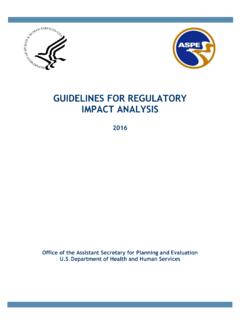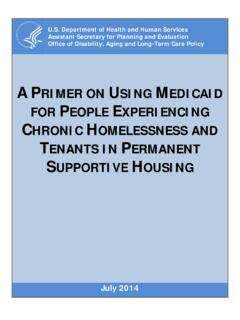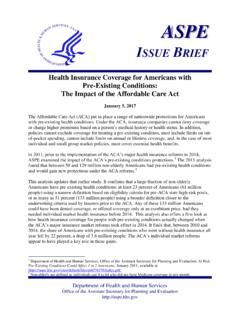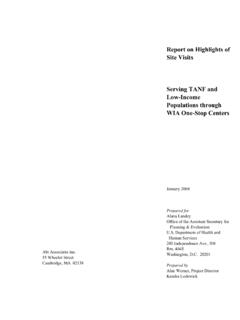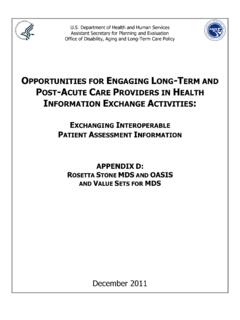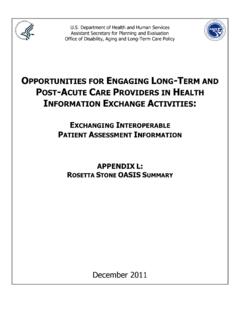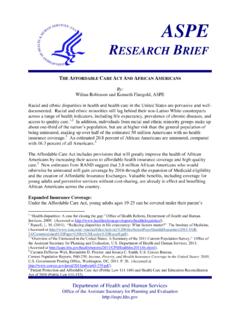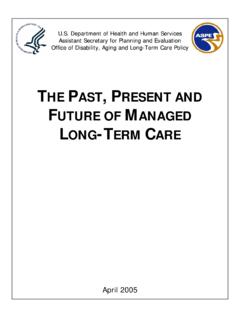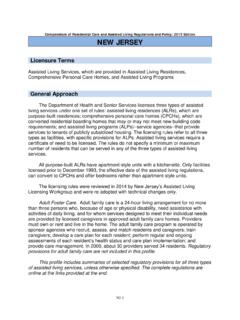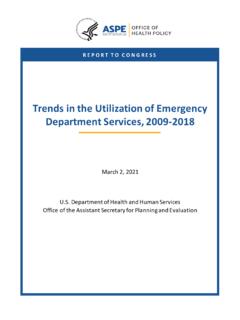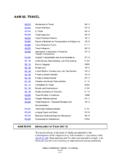Transcription of Addressing Trauma in American Indian and Alaska Native …
1 FINAL REPORT Addressing Trauma in American Indian and Alaska Native Youth August 24, 2016 Amanda Lechner Michael Cavanaugh Crystal Blyler Submitted to: Department of health and Human Services Assistant Secretary for Planning and Evaluation 200 Independence Ave., SW Washington, DC 20201 Project Officer: Amanda Cash Task Point of Contact: Adelle Simmons Contract Number: HHSP23320095642WC/HHSP23337039T Submitted by: Mathematica Policy Research 1100 1st Street, NE 12th Floor Washington, DC 20002-4221 Telephone: (202) 484-9220 Facsimile: (202) 863-1763 Project Director: Deborah Chollet Reference Number: 40146 This page has been left blank for double-sided copying.
2 Addressing Trauma IN American Indian AND Alaska Native YOUTH MATHEMATICA POLICY RESEARCH CONTENTS INTRODUCTION .. 1 SCOPE OF ENVIRONMENTAL SCAN .. 2 SUMMARY OF ENVIRONMENTAL SCAN RESULTS .. 3 Trauma -INFORMED CARE AND Trauma -SPECIFIC INTERVENTIONS .. 4 Cognitive Behavioral Intervention for Trauma in Schools (CBITS) .. 5 Honoring Children, Mending the Circle .. 5 Honoring Children, Respectful Ways .. 6 Pathway to Hope .. 6 INTERVENTIONS FOCUSED ON SUICIDE PREVENTION AND SUBSTANCE USE DISORDERS .. 7 American Indian /Zuni Life Skills Development Program.
3 7 Honoring Children, Honoring the Future .. 7 Community-based college suicide prevention program .. 8 Cherokee Talking Circle and Self-Reliance Model .. 9 Healing of the Canoe .. 9 RezRIDERS .. 10 Interventions listed in the American Indian / Alaska Native Behavioral health Briefing Book .. 10 PARENTING INTERVENTIONS FOR YOUTH AND THEIR GUARDIANS .. 11 Honoring Children, Making Relatives .. 11 Family Group Decision Making (FGDM) .. 11 Our 12 Hemish of Walatowa Family Circle Program .. 12 ASPIRATIONAL FRAMEWORKS .. 13 COMMON ELEMENTS OF PROGRAMS Addressing Trauma AND RELATED BEHAVIORAL health NEEDS IN AI/AN YOUTH.
4 13 CHALLENGES TO CONDUCTING RESEARCH IN TRIBAL COMMUNITIES .. 14 POLICY IMPLICATIONS .. 15 REFERENCES .. 17 APPENDIX A: SYSTEMATIC DATABASE SEARCH METHODOLOGY .. 23 APPENDIX B. SUMMARIES OF INTERVENTIONS AND EVALUATIONS .. 25 iii This page has been left blank for double-sided copying. Addressing Trauma IN American Indian AND Alaska Native YOUTH MATHEMATICA POLICY RESEARCH INTRODUCTION American Indian and Alaska Native (AI/AN) youth experience Trauma at higher rates than other youth in the population. In fact, according to a report by the Indian Country Child Trauma Center (BigFoot et al.)
5 , 2008), Native youth are times more likely to experience Trauma compared to their non- Native peers. A recent report from the Attorney General s Advisory Committee on AI/AN Children Exposed to Violence noted that AI/AN juveniles experience posttraumatic stress disorder (PTSD) at a rate of 22 percent, the same rate as veterans returning from Iraq and Afghanistan, and triple the rate of the general population (Dorgan et al. 2014; Robin et al. 1996). Research also shows higher rates of related behavioral health concerns, including high occurrence of alcohol and substance abuse, mental health disorders, suicide, violence, and behavior-related chronic diseases across Indian Country, which continue to have a profound effect on individuals, families, and communities ( Indian health Service, 2011; Boyd-Ball , et al.
6 2006). According to the Centers for Disease Control and Prevention (CDC), suicide disproportionately affects AI/ANs and is the second leading cause of death for those between the ages of 10 to 34 (2013). The suicide rate among American Indian / Alaska Native adolescents and young adults ages 15 to 34 ( per 100,000) is times higher than the national average for that age group ( per 100,000) (CDC 2013). In some locales (including, for example, many tribal Alaskan villages), Native youth complete suicide at a rate 17 times the average ( Alaska Injury Prevention Center, 2007; Wexler and Gone, 2012; Wexler et al.
7 2008). Many studies of Trauma in AI/AN youth emphasize the concept of historical Trauma as a distinct from other forms of Trauma . For example, among AI/AN youth, Trauma includes both individual experiences of violence and loss as well as forms of distress connected to historical events, cultural destruction, and ongoing experiences of poverty and discrimination (Kirmayer et al. 2014). The term historical Trauma encompasses the cumulative exposure of traumatic events that affect an individual and continue to affect subsequent generations (Yellow Horse Brave Heart, 1993; 1999; 2012).
8 As it was initially described, the term brought together notions of historical oppression and current experiences of psychological suffering (Kirmayer et al. 2014; Yellow Horse Brave Heart, 1993, 1999). The concept is now widely used to describe the long term, intergenerational impact of colonization, cultural suppression, and historical oppression of Indigenous peoples (Kirmayer et al 2014). The intergenerational aspect of historical Trauma points to internalized and unresolved grief that continues to impact the lives of AI/AN youth today. An example of the process by which historical Trauma continues to affect AI/AN youth today is the long-term impact of the Boarding School Era (1870s-1930s).
9 Federal policy mandated the removal of children (in many cases forcibly) from their families and communities in order to attend government- or church-run boarding schools. The goal of the boarding schools was forced assimilation into the dominant society and ultimately the elimination of Native languages and cultures. At the boarding schools, children were not allowed to speak their language, practice their religion, or maintain cultural or spiritual practices and were severely punished for doing so. Moreover, key components of Native identity were eliminated or altered.
10 1 Addressing Trauma IN American Indian AND Alaska Native YOUTH MATHEMATICA POLICY RESEARCH For example, children were usually given new Western names, their hair was cut,1 and ceremonial objects, traditional clothing, and cultural comforts such as toys, dolls, and games were destroyed. Disease, along with physical, psychological, and sexual abuse, was prevalent. For tribal communities, this is a living history. The pernicious effects of the boarding schools and associated Trauma and culture loss continue to negatively impact individuals and communities.
